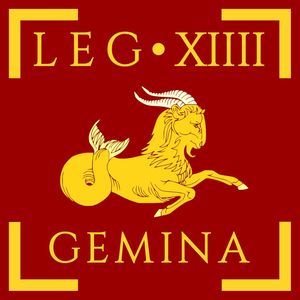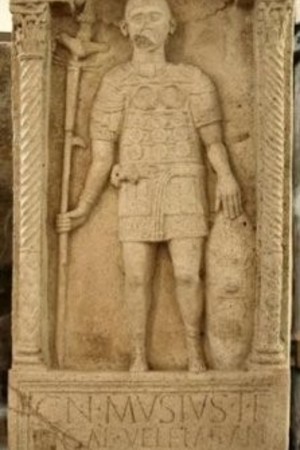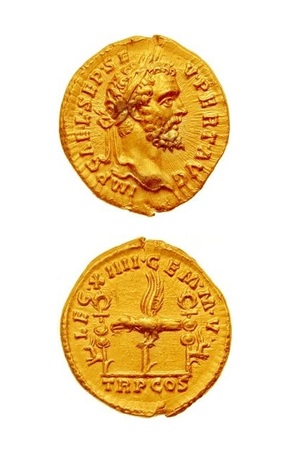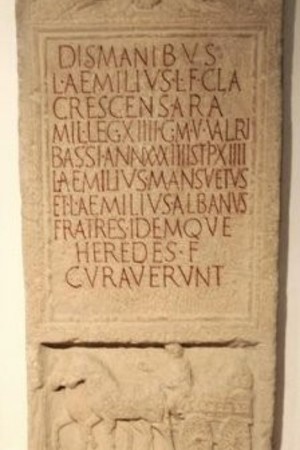Roman Legion - Legio XIIII Gemina Martia Victrix
Legio XIIII Gemina Martia Victrix (Fourteenth Legion Twin Martia Victrix) was a Roman legion formed by Gaius Julius Caesar during the Republic era.
Dates of existence: 57 BC and lasted until the early 5th century AD.
Symbol: Unicorn
Nicknames: Gemina (twin), Martia (of Mars), Victrix (victorious), Pia VI Fidelis VI (loyal and faithful for the sixth time)
Battle Path
- Legio XIIII was created by Gaius Julius Caesar to participate in the Gallic War (58-50 BC).
- The legion's baptism by fire occurred in the Gallic War at the Battle of the Sabis River (now the Sambre River, in France and partially in Belgium) in 57 BC against the Nervii tribe (one of the Belgic tribes).
- In 53 BC, Legio XIIII was nearly completely destroyed by the leader of the Eburones tribe, Ambiorix, in a battle in the area between the Meuse and Rhine rivers.
- In 52 BC, Legio XIIII, replenished with new recruits, was restored and took part in the siege of Alesia (modern Alise-Sainte-Reine, France).
- In the Civil War (49-45 BC) between Pompey and Caesar's supporters, the legion fought on Caesar's side.
- In this war, the legion participated in the following battles: the Battle of Ilerda - 49 BC (Spain); the Battle of Dyrrhachium (modern Durres, Albania) - 48 BC; the Battle of Pharsalus - 48 BC.
- In 46 BC, Legio XIIII participated in Caesar's African campaign. Afterward, the legion was disbanded, and its veterans settled in Italy.
- In 41 BC, the legion was reformed by Caesar's successor, Octavian Augustus.
- There are two versions of its reformation: The first states it was reformed from Caesar's legion veterans and new recruits, while the second version says it was a new legion given Caesar's legion's name. The unicorn symbol, Octavian's personal symbol, supports the latter version, whereas Caesar's symbol was the bull.
- The legion was reformed to fight Pompey the Great's son, Sextus, who controlled Sicily.
- In 31 BC, after defeating Mark Antony at the Battle of Actium, soldiers from Antony's legion were transferred to Legio XIIII, it was given the cognomen Gemina (Twin), and relocated to Illyricum (western Balkan Peninsula).
- In AD 6, the legion participated in Tiberius' campaign against the Germanic Marcomanni tribe.
- In AD 9, the legion was moved to Mogontiacum (modern Mainz, Germany). Many remains of this legion's presence exist, including the tombstone of the aquilifer (standard-bearer) Gnaeus Musius.
- In AD 21, it suppressed the Turoni tribe's uprising in Gaul.
- During Emperor Caligula's reign, in AD 41, Legio XIIII Gemina took part in the emperor's German campaign under future Roman Emperor Galba's command.
- Under Emperor Claudius, Legio XIIII Gemina participated in the AD 43 invasion of Britain, where it actively fought the Britons.
- In Britain, the legion's camp was initially in Manchester and later in Lincolnshire.
- Under Emperor Nero, Legio XIIII Gemina remained in Britain, participating in the suppression of Boudica's revolt (AD 61) under Gaius Suetonius Paulinus. For this, Emperor Nero awarded the legion the title “Martia Victrix” (“Victorious, blessed by Mars”), later mentioned as part of the cognomen.
- In AD 67, Legio XIIII Gemina was transferred from Britain to the Balkans.
- In AD 68, during the Year of the Four Emperors, after Emperor Nero's death, the legion sided with Galba, then supported Otho, and after his defeat by Vitellius, the legion did not further participate in Vitellius' and Vespasian's struggle.
- In AD 70, Legio XIIII Gemina, part of Cerialis' forces, participated in suppressing the Batavian revolt.
- After the suppression, the legion was transferred back to Mogontiacum (modern Mainz, Germany), sharing its camp with Legio I Adiutrix.
- During Emperor Domitian's reign, the legion supported the rebellious governor of Upper Germany, Lucius Saturninus, in AD 89, but after the rebellion's suppression, Legio XIIII Gemina was minimally punished. Only the most active rebels among the legionnaires and officers were executed.
- In AD 92, the legion was transferred to Pannonia, initially to Mursa (modern Osijek, Croatia) and then to Vindobona (modern Vienna, Austria). Here, the legion participated in battles against the Suebi and Sarmatians.
- During Emperor Trajan's reign, the legion participated in the Dacian Wars (AD 101-106). After the wars, Legio XIIII Gemina camped at Carnuntum (now ruins in Petronell-Carnuntum, near Vienna, Austria), remaining the legion's base until its dissolution in the early 5th century AD.
- In the 2nd century, the legion participated in the military campaigns of Emperors Antoninus Pius (138-161), Lucius Verus (161-169), and Marcus Aurelius (161-180).
- In the Year of the Five Emperors (AD 193), Legio XIIII Gemina supported Septimius Severus, bringing him the imperial purple and throne. It participated in the battle against Pescennius Niger's forces at Issus (modern Issus, Turkey) in the spring of AD 194.
- In the 3rd century, the legion was still stationed at Carnuntum but sent its vexillations to participate in the campaigns of Emperors Gordian III (238-244) and Philip the Arab (244-249).
- In AD 260-261, Legio XIIII Gemina supported the usurper Regalianus against Emperor Gallienus (253-268) in Pannonia. Then it switched sides to support Emperor Gallienus against Postumus (260-268), receiving the titles Pia VI Fidelis VI (“Loyal and Faithful for the sixth time”) in gratitude.
- After Emperor Gallienus' death in AD 268, Legio XIIII Gemina sided with the Gallic Emperor Victorinus (269-271).
- In the 4th century, Legio XIIII Gemina participated in Emperor Valens' campaign on the Danube (AD 364-378).
- In the early 5th century, the legion was still at Carnuntum (now ruins in Petronell-Carnuntum, near Vienna, Austria). With the Roman withdrawal from the Danube in AD 430, the legion ceased to exist.
Related topics
List of Roman Legions, Legion, Legionnaire, Gaius Julius Caesar, Octavian Augustus, Year of the Four Emperors, Year of the Five Emperors, Legio I Adiutrix, Marcus Ulpius Nerva Trajan
Literature
1. Dandelot-Collins. Legions of Rome.
2. R. Kanya. A brief history of the various legions.






